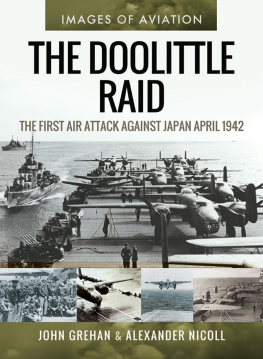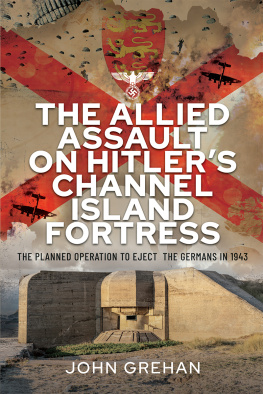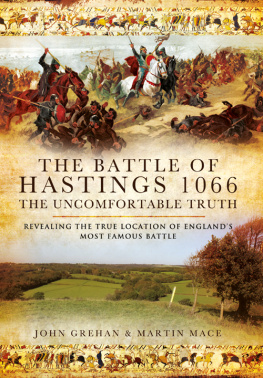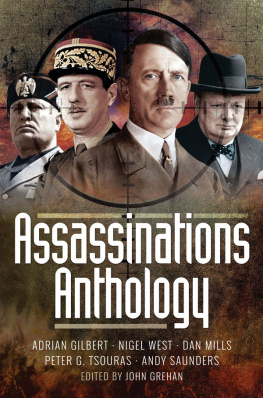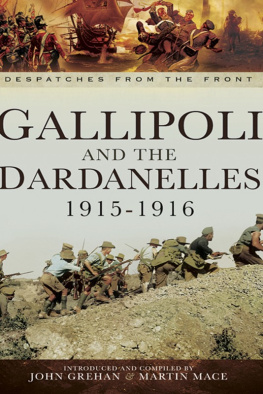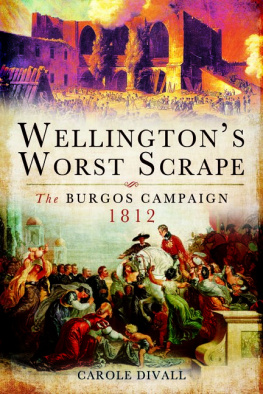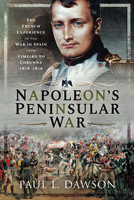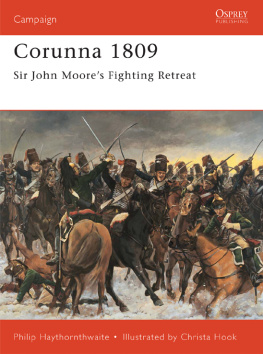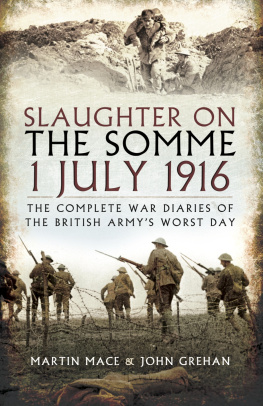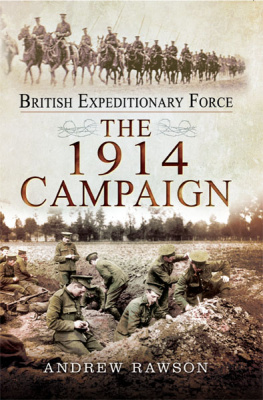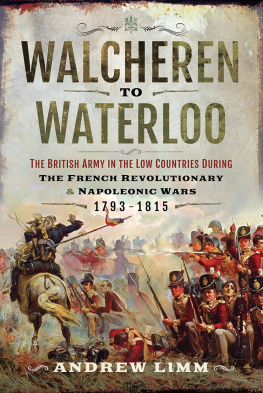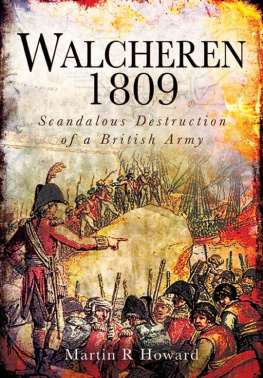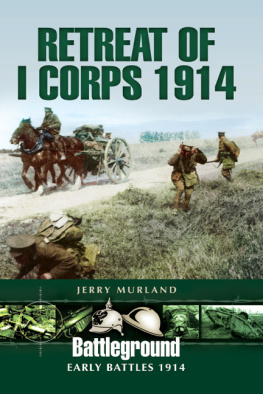THE HUNT FOR MOORES GOLD
THE HUNT FOR MOORES GOLD
INVESTIGATING THE LOSS OF THE BRITISH ARMY MILITARY CHEST DURING THE RETREAT TO CORUNNA
THE HUNT FOR MOORES GOLD
Investigating the Loss of the British Armys Military Chest
During the Retreat to Corunna
First published in Great Britain in 2019 by Frontline Books,
an imprint of Pen & Sword Books Ltd, Yorkshire - Philadelphia
Copyright xxxx xxxx
ISBN: 978-1-52673-053-4
eISBN: 978-1-52673-054-1
Mobi ISBN: 978-1-52673-055-8
The right of John Grehan to be identified as Author of this work has been asserted by him in accordance with the Copyright, Designs and Patents Act 1988. A CIP catalogue record for this book is available from the British Library All rights reserved.
No part of this book may be reproduced or transmitted in any form or by any means, electronic or mechanical including photocopying, recording or by any information storage and retrieval system, without permission from the Publisher in writing.
Pen & Sword Books Ltd incorporates the imprints of Pen & Sword Archaeology,
Air World Books, Atlas, Aviation, Battleground, Discovery, Family History, History,
Maritime, Military, Naval, Politics, Social History, Transport, True Crime, Claymore
Press, Frontline Books, Praetorian Press, Seaforth Publishing and White Owl
For a complete list of Pen & Sword titles please contact:
PEN & SWORD BOOKS LTD
47 Church Street, Barnsley, South Yorkshire, S70 2AS, UK.
E-mail:
Website: www.pen-and-sword.co.uk
Or
PEN AND SWORD BOOKS,
1950 Lawrence Road, Havertown, PA 19083, USA
E-mail:
Website: www.penandswordbooks.com
Acknowledgements
I am grateful for the time and effort contributed by D. Jess Manuel Nez Daz, Consuelo McMurdo, Professor Javier Gomez, Alfredo Erias Martinez, the director of the Archives of Betanzos, and Laurie Dennett, whose combined knowledge of the Lugo region proved invaluable. I am especially thankful to Luis Coedonova for his warm hospitality.
The trip to the mountains of Galicia simply would not have been possible but for my son, Marcus, who somehow managed to drive along the narrowest, rockiest tracks imaginable while maintaining his perpetual optimism. Military artist David Rowlands was the man behind the lens, taking photographs of almost every point along the line of the retreat to Corunna. His knowledge of British military history is quite exceptional. Thanks to Charlotte Rowlands for her Spanish translations.
My thanks also to Robert Mitchell and the historian and Peninsular War tour leader Nick Lipscombe for their assistance, and Hannah Fadairo for all the support she gave me.
Most especially, the one person who has devoted very considerable time talking to almost everyone he could find in the Becerrea region and, as I write these acknowledgements, is still investigating, is Angel Rodil Perez .
Martin Mace deserves particular credit for telling me to stop talking about the loss of Moores military chest and to go and look for it and for publishing this book.
List of Maps
The Peninsula Campaign 18081814
The Retreat to Corunna and Vigo (Dave Cassan)
Nogales to Cereixal (Dave Cassan)
Cereixal to Baralla (Dave Cassan)
Introduction
The Quest for the Chest
O h, beg pardon, sir, said the blue-coated officer; I am paymaster general The treasure of the army, sir, is close in the rear, and the bullocks being jaded are unable to proceed. The officer that the paymaster general had addressed was General Paget in charge of the retreating armys rear-guard. Paget had no time, or men, to spare to deal with the paymaster generals problems, for he had an enemy to fight.
That enemy was creeping round the rear-guards right flank and the military treasure chest, heavy and immobile on the carts of the exhausted cattle, was certain to be overtaken by the pursuers. Paget had no choice. The money had to abandoned.
The Light Company of the 28th Regiment was ordered to the rear in double-quick-time to hold back the French cavalry as the remainder of the regiment drew up in close order around the two the paymaster generals carts. The military chests were then opened and the treasure of the army, silver and possibly gold specie, was thrown over the snow-covered cliff into the ravine below. As they rolled down the precipice, their silvery notes were accompanied by a noble bass, wrote a youngofficer of the 28th, Robert Blakeney for two guns were thundering forth their applause into Soults dark brown column as they gallantly pressed forward.
Anyone who has read the history of Sir John Moores retreat to Corunna will know of the story of the armys military chest being thrown into a deep ravine rather than allowing it to fall into the hands of the enemy. But just how true is this tale and exactly how much treasure was lost? How much of it was seized by the passing troops and was any recovered by the local Spanish peasants when the snow thawed and coins were exposed? Perhaps more importantly, is there any of that treasure still sitting at the bottom of the ravine?
For years, I have pondered these questions, indeed my personal journey began when I purchased a copy of Blakeneys memoirs at a table-top sale at a gymkhana in the New Forest whilst on a farm holiday with my family. Remarkably, the book was signed and dated July 1900 (just after the book had first been published), and was given as a present to Fanny Blakeney. It cost me just 10p!
After decades of wondering what had happened to the military chest I had to accept that there was only one way to find out by looking for myself. Thus began this quest to discover, once and for all, what happened to Moores gold.
The approach I am taking in this book, is to retell the story of the retreat to Corunna in as great a detail as I possibly can. This, I hope, will enable me to understand the circumstances around the loss of the military chest, and its exact location. The retreat to the coast of northern Spain and the battle outside the port of Corunna to hold back the French before the battered and bloody British army was able to safely embark on the ships that would carry them to England, is also one of the most dramatic tales in British military history and well worth the retelling, drawing on the standard accounts of the retreat, as well as some that have not been presented to the public for more than 200 years, and a number that have only recently become readily available.
The second part of the book will focus on the events of that cold winter evening of 5 January 1809 and culminate in an expedition to Galicia to investigate in person the possible site where the sacks holding the military chest were discarded. As I write this introduction I do not know where this journey will take me, or where it will finish. It might be that I can positively identify the location of the lost treasure but that the slope is too steep to be climbed, I simply do not know.


